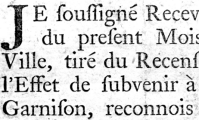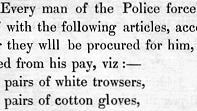




















|
|

The section concerning Justice shows books used by lawyers, judges, members of elected political bodies, and officers of the militia. These works established the order of practice and provided official wording of laws. Their use was limited to a small number of well-educated men. What was crucial for most, on the other hand, was the ability to read the broadsides announcing rules and regulations which effected all Canadians.
The quest for responsible government during the 1830s and 1840s gave rise to numerous pamphlets, newspapers, and broadsides. Political propaganda issued by individuals, or later organized political parties, was always plentiful. Most early speeches could be found in the local newspapers, but some were printed in leaflet form to be distributed during rallies and public debates. As the electoral process evolved, and women gained the right to vote, the printed word became a widespread means of swaying opinion, advertising rallies, and announcing results of elections.

Most of the early printers survived by doing job printing for the government and merchants of a city. This receipt concerns the practice of billeting soldiers of the garrison in private houses. It is the earliest example of printing in the Province of Quebec held by the National Library of Canada.
|

|
Nicolas-Gaspard Boisseau, 1726-1804
Je soussigné receveur, nommé par le comité...fait à Québec, le dix huit janvier, mil sept cens soixante et cinq.
[Quebec: William Brown and Thomas Gilmore, 1765].
|

Since the Sedentary Militia was unskilled and untrained, the publication of this manual was needed as war was approaching. War was declared on June 18, 1812.
Bas-Canada - Adjutant général des milices
Rules and Regulations for the Formation, Exercise & Movements of the Militia of Lower-Canada / Regles & reglemens pour la formation, l'exercice et mouvement de la milice du Bas-Canada.
Quebec: New Printing Office / Nouvelle Imprimerie, 1812. 248, [4] p.

Suzor played an important role in the integration of Francophones in the militia and was an exceptional educator. His numerous manuals, for the most part translations or adaptations of English manuals, were the only ones available at the time and were used for generations. This handbook contains the English terms most commonly used in the French militia. Copy with the signature "Boucher de la Bruère" on the wrapper, probably Pierre-Claude Boucher de la Bruère (1808-1871), medical doctor and patriot of 1837, who was named major of the Fifth Batallion of the militia of Saint-Hyacinthe, Quebec in 1847.
|

|
Louis Timothée Suzor, 1834-1866
Aide-mémoire du carabinier volontaire: Comprenant une compilation des termes de commandement usités dans l'armée anglaise...
Québec: S. Derbishire et G. Desbarats, 1862. 52 p.
|

At that time, texts of laws were read in public, that is to say "published." They were also posted in public areas. The manuscript text in the margin reads as follows: "I do hereby certify that I have on the 28th day of February, the 1st & 2d March 1809, published the within Regulations of Police in English and French Language throughout all the City of Montreal and the Suburbs, and on the 2d & 3d March, being two market days, on three different places on the old Market place only, each day. Montreal 3d March 1809. A. (?) Kollmyer, pub. cryer.
I do hereby certify that I have on this 4th day of March 1809, posted up the within Regulations of Police at the Court House, on the New Market and old Market places, at the four corners of the City of Montreal, and at the French Church door. Montreal, the 4th March 1809. A. (?) Kollmyer. pub. cryer."
[Regulations of police for the city of Montreal]
At a Court of General Sessions of the Peace... / A une cour de sessions générales de la paix...
[Montreal, 1809].

Coffin was commissioner of police for Montreal. He was instrumental in implementing a police force for the province of Quebec. On the front pastedown, one reads: "William F. Coffin, his book - made by himself. The only copy left 16 Mar. 1855."
|

|
William Foster Coffin, 1808-1878
Regulations for the Governance of the Police Force, Rural and City, Province of Canada: With Instructions as to the Legal Authorities and Duties of Police Constables.
Montreal: Printed by J. Starke, 1841. 39 p.
|

This work was written by an inspector of the Royal Canadian Mounted Police in Saskatchewan. "Nothing has been said in this Manual regarding so-called ‘Detective work'. The detection of crime is an art and not a science, therefore little can be written upon it, but much learnt by observation of all that goes on around one by those who have a natural aptitude for investigation." Times have changed!
J. Howard Townsend, 1881-1927
Canadian Constables' Manual.
Toronto: Carswell, 1925. vii, 293 p.

|
